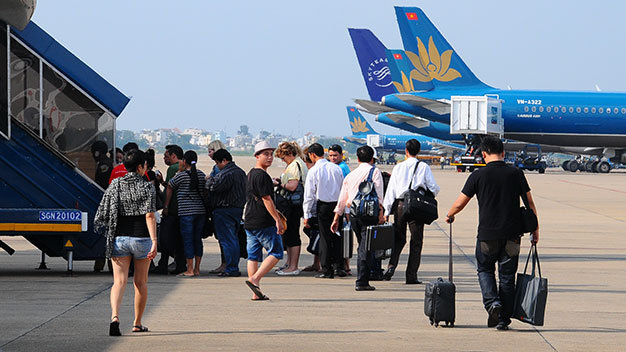A Vietnamese economic expert has suggested shutting down Ho Chi Minh City’s Tan Son Nhat International Airport to free up an 800 hectare land plot that could generate a huge source of capital to finance the multibillion-dollar construction of another, bigger airport in a neighboring province.
Now handling around 20 million passengers a year, Tan Son Nhat is currently Vietnam’s largest airport, and is expected to become overloaded by 2017, whereas Long Thanh is planned to be built in the eponymous district of the southern province of Dong Nai.
The first phase of the Long Thanh project is expected to require US$7.83 billion worth of investment. Funding the costly plan is a huge challenge for the Ministry of Transport, its developer, and the government.
“Should the government still face difficulties in financing the project, it should consider closing Tan Son Nhat and moving all aviation activities to the newly-built airport,” said Nguyen Xuan Thanh, director of the Fulbright Economics Teaching Program in Vietnam.
The 800 hectare land plot that would be left if the airport were shut down will fetch no less than $8 billion, or $1,000 per square meter, Thanh said in an op-ed published in Tuoi Tre (Youth) newspaper on Friday.
Under the plan to develop Long Thanh airport, Tan Son Nhat will remain operational after the new airport is commissioned.
Long Thanh will mostly serve international passengers, and a small number of domestic travelers, while the Ho Chi Minh City terminal will mostly receive domestic passengers, and a smaller number of international customers.
The plan is based on the fact that in 2022, when the Long Thanh airport is expected to open to passengers, Tan Son Nhat will be serving 25 million passengers a year, so it could not be closed, Thanh, a Harvard Kennedy School senior fellow, wrote, quoting the plan’s details.
“The planners say the facilities at Tan Son Nhat are quite new, so they must continue to be used,” Thanh wrote.
“But is it really necessary to keep Tan Son Nhat airport forever, when we already have Long Thanh?”
The pundit said the government should consider shutting down Tan Son Nhat and making use of its land plot after 2025.
“If this route is taken, the National Assembly can allow the government to issue a long-term infrastructure bond for the Long Thanh project, which would be assured by the land at Tan Son Nhat,” he said.
The profits from both terminals would be used to pay interest on the bond.
“After the Ho Chi Minh City terminal has been closed, its land plot can be exploited to generate revenue to pay the bond debt.”
Thanh said the southern economic hub will have to ‘sacrifice’ its airport.
“But in return, the government – or in fact current and future taxpayers – will not have to bear the debt-paying burden for the new Long Thanh airport,” he pressed.
“Moreover, Ho Chi Minh City will have the chance to develop a new, modern and civilized urban area on the land where Tan Son Nhat used to sit.”
Financially infeasible
Also in his piece, Thanh acknowledged the necessity of building a new airport, but asserted that financially speaking, the plan lacks feasibility.
The transport ministry said in its investment report that the social rate of return, which measures the net benefits to society of an infrastructure project, of the Long Thanh airport is 22.1 percent a year.
But Thanh said all sources of earning, from passenger service, airplane and other aviation fees to income from leasing space for airport shops or restaurants, are not enough to cover the investment and operation costs.
“Let’s take Tan Son Nhat for an example. The profit from the terminal is currently $1.6 per passenger, while the figure for Singapore’s Changi is $6 per passenger,” Thanh said.
“Suppose that Long Thanh airport operates effectively and has a $3 per passenger profit ratio, it would still only generate $75 million worth of profits from 25 million passengers.”
During its first phase, ending by 2025, the 5,000-hectare Long Thanh terminal is expected to receive 25 million passengers and handle 1.2 million metric tons of goods a year, according to the development plan.
The $75 million in earnings would not even enough to repay the interest on the roughly $8 billion loan that would be needed for Long Thanh’s first phase, even at a one percent lending interest rate, Thanh said.
The investment report also suggests charging passengers a $5 user development fee (UDF) to reduce the financial burden for the government.
“The question is whether passengers would be willing to pay the UDF, while they already have to pay more to get to the airport?” he said.
Passengers in Ho Chi Minh City have to travel an average of 7km to Tan Son Nhat airport, while the distance would be 35km for Long Thanh.
Like us on Facebook or follow us on Twitter to get the latest news about Vietnam!





















































